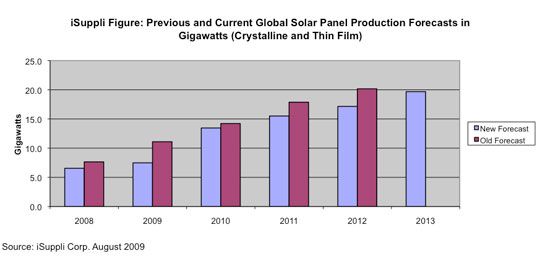Adjusting production output to meet market demand is always considered a prudent move in the solar business, apparently.
While some solar panel makers have dialed down their production volumes, the industry overall is still churning out way too many products. The problem is so bad that the glut is likely to stay until 2012, according to a new report by iSuppli, a market research firm in El Segundo, Calif.
Solar panel production worldwide would increase 14.3 percent to reach 7.5 gigawatts in 2009, compared with 6.5 gigawatts in 2008, said iSuppli.
But the research firm, which has lowered its forecast for the next several years, believes only 3.9 gigawatts would be installed this year.
The revised outlook signaled yet again the volatility of this young industry, which experienced a great boom last year thanks mainly to the lucrative incentives in Spain.
Spain accounted for about half of installations globally in 2008, Henning said. It was well known by last fall that the country would be a much smaller market this year because of a new cap in place.
The financial market crisis has pummeled the solar market, starting late last year. Meanwhile, the United States is still implementing its stimulus policy that is set to provide billions of dollars in grants and loans to solar energy equipment makers and project developers over the next two years. Analysts say the policy won't likely make a big impact until 2010 (see Reality Check: How Much Impact Can the Feds Have on Solar?)
Large solar panel makers from Suntech Power to SunPower all have suffered financially as a result of the poor economy. SunPower in San Jose, Calif., managed to improve its second-quarter numbers after scaling back production plans (see SunPower Posts 2Q Profit, Feels Upbeat About Future).
Wicht said companies such as Suntech, Sharp and JA Solar are continuing to expand their manufacturing capacities "as if a recession had never occurred." Many of these companies are boosting their production capabilities to maintain their market share, he added.
Some of these companies also might be banking on a much improved market next year. The U.S. government's stimulus package is supposed to make it easier for project developers to line up financing for building solar power plants.
The Chinese government also has announced solar incentives that should benefit its domestic producers, who have exported the vast majority of their solar energy equipment and have taken a beating in the market.
Since the government announcements, a host of Chinese solar companies, including Suntech, ReneSola and Yingli Green Energy, have announced plans to co-develop hundreds of megawatts with investors or power companies (see True or False: China Will be a Bigger Solar Market Than the U.S. and Green Light post).
iSuppli has revised its solar panel production forecast to 13.5 gigawatts from its previous prediction of 14.2 gigawatts. By 2012, the production should reach 17.2 gigawatts instead of 20.2 gigawatts.



